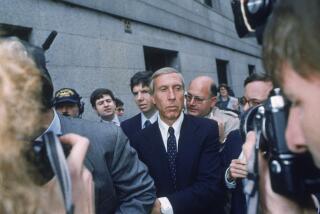Inside Trades May Be Investment Weather Vane
- Share via
Corporate insiders sell their own shares at a rapid pace in the years prior to a voluntary bankruptcy filing, saving their own financial skins while other shareholders sustain substantial losses, according to a recently released study.
The study, which urges change in current bankruptcy laws, also supports what insider trading experts have long contended. If you look carefully and know what to consider, watching insider trading can give investors an edge.
Insiders, defined as company officers, directors and large shareholders, must report trades of their firms’ shares to the Securities and Exchange Commission. The data is available to the public through newsletters and data retrieval services. The Times publishes details of insider trading at local companies on Page D6 most Sundays.
“Assuming you already own a company’s stock, knowing what the top executives are doing is quite useful,” said H. Nejat Seyhun, associate professor of finance at the University of Michigan. “If they are buying, I would feel more comfortable. If they were selling, I would consider it a red flag that would cause me to look further.”
Studying insider trading activity can also signal which stocks might be worth adding to your portfolio, adds George S. Shirk III, research analyst at The Insiders, a twice-monthly Ft. Lauderdale newsletter on insider trading.
However, insider activity should not be the only information investors consider. They should also look at how the company’s stock price relates to its earnings, whether the company pays a dividend, and what’s happening with its earnings per share.
“You need to look for solid fundamentals,” Shirk adds.
Still, insider buying and selling can be a potent indicator of what’s to come at an individual firm, as well as in the market as a whole, Seyhun says.
Consider Seyhun’s most recent study, which largely concentrates on the darker side of insider trading. The study examines 348 bankruptcy filings made by 335 companies--some filed bankruptcy twice--between 1963 and 1991.
Common shareholders of these firms lost 75% of their investment, on average, during the two years prior to the bankruptcy filing. A large portion of that loss was concentrated in the month of filing, according to the study.
Top executives, on the other hand, started to sell off their holdings as much as five years prior to the filing. In the two years prior to the filing, top executives sold almost seven times the number of shares that they purchased, the study says.
“Corporate managers know full well the implications of filing a bankruptcy petition, and they take appropriate actions to reduce the impact on their personal wealth,” Seyhun says.
Notably too there is a positive relationship between insider buying during the bankruptcy process and the probability that the firm emerges from bankruptcy reorganized as opposed to being liquidated, Seyhun says.
However, the “precision” of insider trading data varies dramatically based on what position the insider holds.
By and large, Seyhun found that top executives--chairmen, chief executives, chief financial officers and directors--are far more likely to signal the stock price’s direction through their trades than are company managers or other insiders, such as large shareholders.
Additionally, Seyhun and other experts maintain that not all trades are meaningful. Small purchases and sales, private transactions, “consensus decisions” and stock options are probably best filtered out, Shirk says.
That’s because private sales and purchases--those not done on the open market--are often arrangements between friends. Perhaps a director is retiring and wants to sell his shares before he goes; the chief executive or another director may agree to buy them even if they wouldn’t otherwise be buyers of the stock.
Consensus buying or selling should also be viewed with caution, Shirk says. That’s when several executives buy at the same time and same price. They may have all been affected by a group meeting, so their purchases or sales should be considered essentially one trade, he says.
Additionally, corporate executives get stock options--rights to buy company shares at a set price in the future. Frequently, when these options become valuable, managers exercise the options, which triggers a taxable gain. They then sell some of the shares to pay the tax. Such moves have little to do with the company’s prospects.
Finally, trades of 100 shares by someone who owns hundreds of thousands or millions of shares are just not significant enough to consider.
What should you consider? If, over a period of time, there are far more inside buyers than sellers, that should be a clue that the company’s prospects are bright and vice versa. Also watch for top officers and directors who buy or sell large blocks of stock--boosting or decreasing their holdings by 5% or 10%, for example.
Strong insider buying when the company’s shares have been level or rising is more positive than buying when they’ve been falling, Seyhun adds.
More to Read
Inside the business of entertainment
The Wide Shot brings you news, analysis and insights on everything from streaming wars to production — and what it all means for the future.
You may occasionally receive promotional content from the Los Angeles Times.










